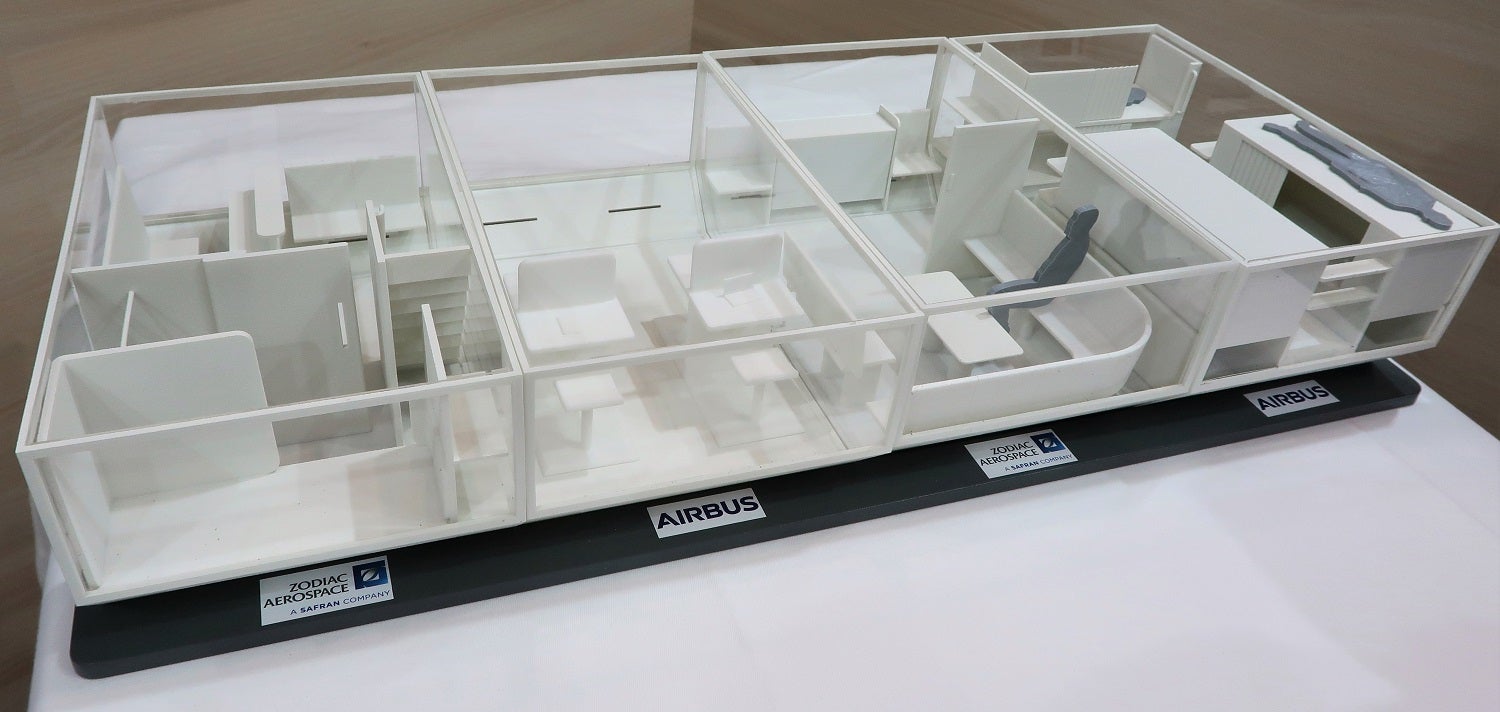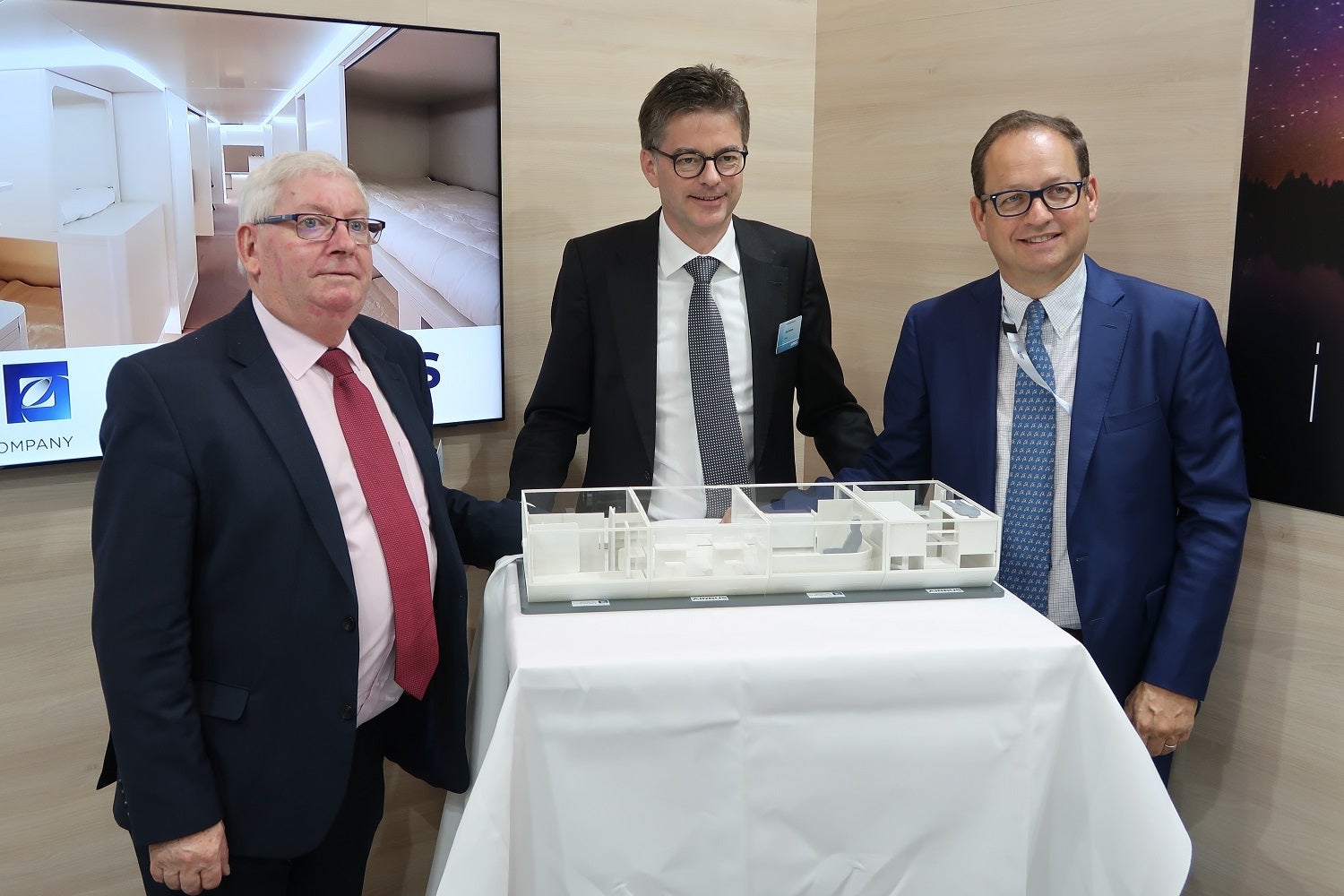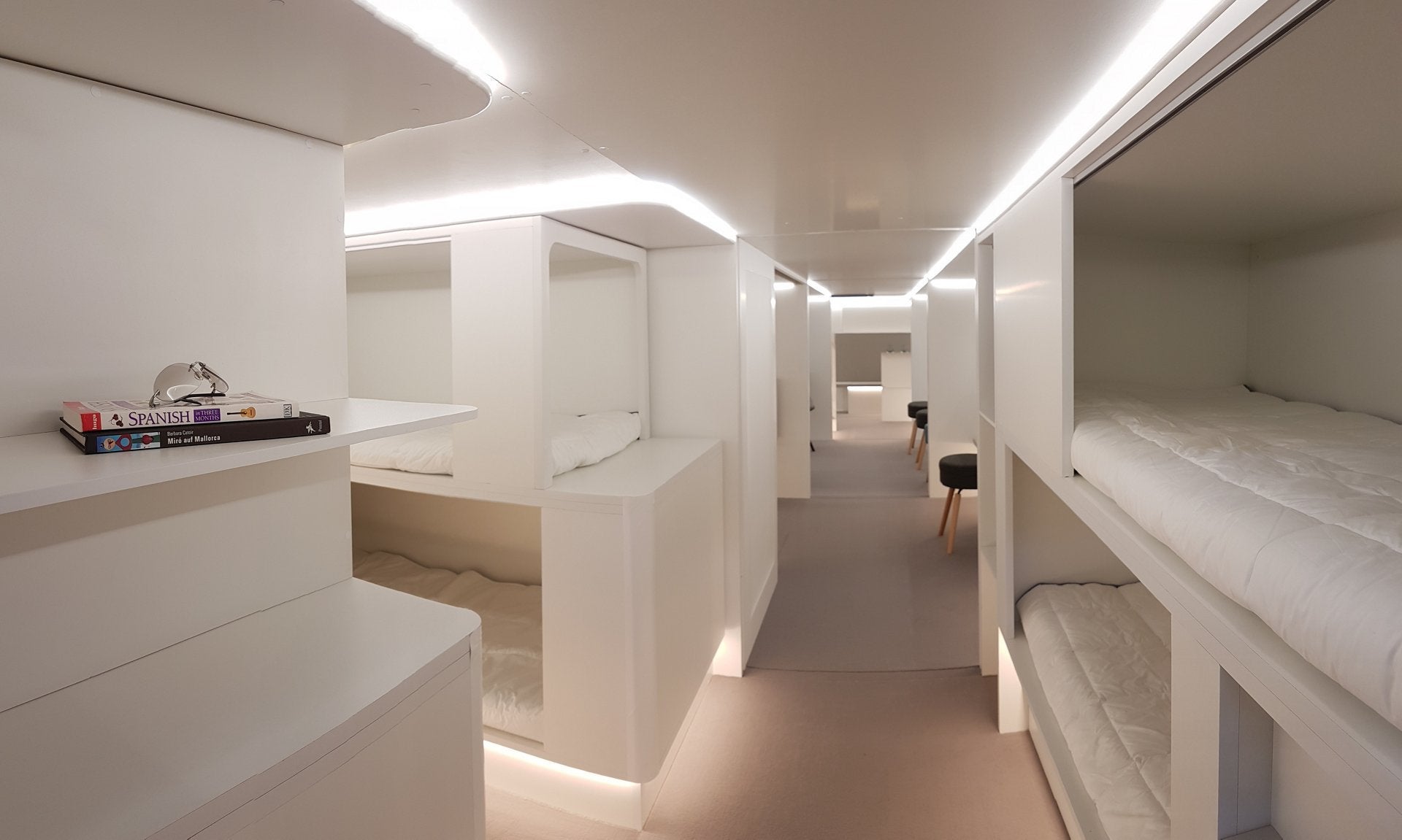Airbus Unveils Cargo Deck Sleeping Compartments With Up to 24 Bunks
Just after arriving in London on the Perth-London inaugural, Qantas CEO Alan Joyce made news by discussing the idea of having sleeping berths and exercise areas in the cargo deck of an aircraft. Now, Airbus and Zodiac have signed a partnership to make that idea a reality by 2020.
Announced in a closed-door ceremony at the Aircraft Interiors Expo in Hamburg, the new product would allow airlines to easily add and remove customizable modules into space otherwise reserved for cargo.

For the unveiling, the focus was on the idea of a premium "hotel-like" living space. In the model unveiled in Hamburg, there's only one six-bed sleeping berth while the other modules are dedicated to dining and working areas. However, airlines could choose from a variety of other modules such as lounges, conference rooms, living rooms, combination work/sleep areas and more.
Designed with ease in mind for crew to swap out on an overnight layover, airlines would have the flexibility to choose between cargo and these new living areas — or between different types of modules — on a day-by-day basis.

Geoff Pinner, Airbus' head of cabin and cargo, said after the unveiling that the airlines will be the ones driving the modular innovation. A premium airline would have the option to arrange their cargo deck into a Residence-like living space for ultra-premium passengers.
On the flip side, airlines could install four modules of sleeping berths to be able to provide beds for 24 passengers. And, if six bunks in a roughly 13-by-8-by-5-foot space isn't enough, Pinner said that the Airbus/Zodiac partnership could develop an even higher-density sleeping berth option.

To start out, Airbus is developing the product for the Airbus A330. That's primarily because there are currently around 150 Airbus A330s that already have lower-deck stairs installed for crew rest areas.
Once development and certification of those modules is complete, the aircraft could be able to immediately add modules via existing cargo doors without any retrofit required to install them. Aircraft that don't have lower-deck stairs already installed would only be required to undergo a retrofit to add the stairs before modules could be used.
After introducing it for the A330, the next step for the partnership would be to adapt the product for the A350. Understandably, as the A380 program is on and off the brink of shutting down, Airbus isn't planning to adapt this idea for the superjumbo at this time.

While this is the beginning of an official relationship, Airbus notes that it already has a full-size mock-up of the concept in its Toulouse innovation center. And, it seems that this mock-up has already been visited by a few airlines. In the press release, Pinner is quoted as saying, "We have already received very positive feedback from several airlines on our first mock-ups." When asked for specifics, he noted that it's too early to share which airlines have already expressed interest.
There's one major issue that wasn't addressed in the unveiling: height. With the cargo deck only able to support a module that's 5 feet and 4 inches in height, there's not going to be enough room for most passengers to stand up straight. My assumption is that this is going to be a major factor in airlines opting to go more toward sleeping berths rather than lounges and other premium spaces.
TPG featured card
Rewards
| 2X miles | 2 miles per dollar on every purchase |
| 5X miles | 5 miles per dollar on flights and vacation rentals booked through Capital One Business Travel |
| 10X miles | 10 miles per dollar on hotels and rental cars booked through Capital One Business Travel |
Intro offer
Annual Fee
Recommended Credit
Why We Chose It
The Capital One Venture X Business Card has all the Capital One Venture X Rewards Credit Card has to offer and more. It offers an incredible welcome bonus and requires an equally impressive spend to qualify. In addition, the card comes with premium travel perks like annual travel credit. (Partner offer)Pros
- The Capital One Venture X business card has a very lucrative welcome offer.
- In addition, the card comes with many premium travel perks such as an annual $300 credit for bookings through Capital One Business Travel.
- Business owners are also able to add employee cards for free.
Cons
- The card requires significant spending to earn the welcome offer.
- Another drawback is that the annual travel credit can only be used on bookings made through Capital One Business Travel.
- LIMITED-TIME OFFER: Earn up to 400K bonus miles: 200K miles when you spend $30K in the first 3 months, and an additional 200k miles when you spend $150k in the first 6 months
- Earn unlimited 2X miles on every purchase, everywhere—with no limits or category restrictions
- Earn 10X miles on hotels and rental cars and 5X miles on flights and vacation rentals booked through Capital One Business Travel
- With no preset spending limit, enjoy big purchasing power that adapts so you can spend more and earn more rewards
- Empower your teams to make business purchases while earning rewards on their transactions, with free employee and virtual cards. Plus, automatically sync your transaction data with your accounting software and pay your vendors with ease
- Redeem your miles on flights, hotels and more. Plus, transfer your miles to any of the 15+ travel loyalty programs
- Every year, you'll get 10,000 bonus miles after your account anniversary date. Plus, receive an annual $300 credit for bookings made through Capital One Business Travel
- Receive up to a $120 credit for Global Entry or TSA PreCheck®. Enjoy access to 1,300+ airport lounges worldwide, including Capital One Lounge locations and Priority Pass™ lounges, after enrollment
- Enjoy a $100 experience credit and other premium benefits with every hotel and vacation rental booked from the Premier Collection
- This is a pay-in-full card, so your balance is due in full every month
Rewards Rate
| 2X miles | 2 miles per dollar on every purchase |
| 5X miles | 5 miles per dollar on flights and vacation rentals booked through Capital One Business Travel |
| 10X miles | 10 miles per dollar on hotels and rental cars booked through Capital One Business Travel |
Intro Offer
Earn 200K miles when you spend $30K in the first 3 months, and an additional 200K miles when you spend $150K in the first 6 monthsLIMITED-TIME OFFER: Earn up to 400K bonus milesAnnual Fee
$395Recommended Credit
Credit ranges are a variation of FICO® Score 8, one of many types of credit scores lenders may use when considering your credit card application.740-850Excellent
Why We Chose It
The Capital One Venture X Business Card has all the Capital One Venture X Rewards Credit Card has to offer and more. It offers an incredible welcome bonus and requires an equally impressive spend to qualify. In addition, the card comes with premium travel perks like annual travel credit. (Partner offer)Pros
- The Capital One Venture X business card has a very lucrative welcome offer.
- In addition, the card comes with many premium travel perks such as an annual $300 credit for bookings through Capital One Business Travel.
- Business owners are also able to add employee cards for free.
Cons
- The card requires significant spending to earn the welcome offer.
- Another drawback is that the annual travel credit can only be used on bookings made through Capital One Business Travel.
- LIMITED-TIME OFFER: Earn up to 400K bonus miles: 200K miles when you spend $30K in the first 3 months, and an additional 200k miles when you spend $150k in the first 6 months
- Earn unlimited 2X miles on every purchase, everywhere—with no limits or category restrictions
- Earn 10X miles on hotels and rental cars and 5X miles on flights and vacation rentals booked through Capital One Business Travel
- With no preset spending limit, enjoy big purchasing power that adapts so you can spend more and earn more rewards
- Empower your teams to make business purchases while earning rewards on their transactions, with free employee and virtual cards. Plus, automatically sync your transaction data with your accounting software and pay your vendors with ease
- Redeem your miles on flights, hotels and more. Plus, transfer your miles to any of the 15+ travel loyalty programs
- Every year, you'll get 10,000 bonus miles after your account anniversary date. Plus, receive an annual $300 credit for bookings made through Capital One Business Travel
- Receive up to a $120 credit for Global Entry or TSA PreCheck®. Enjoy access to 1,300+ airport lounges worldwide, including Capital One Lounge locations and Priority Pass™ lounges, after enrollment
- Enjoy a $100 experience credit and other premium benefits with every hotel and vacation rental booked from the Premier Collection
- This is a pay-in-full card, so your balance is due in full every month

